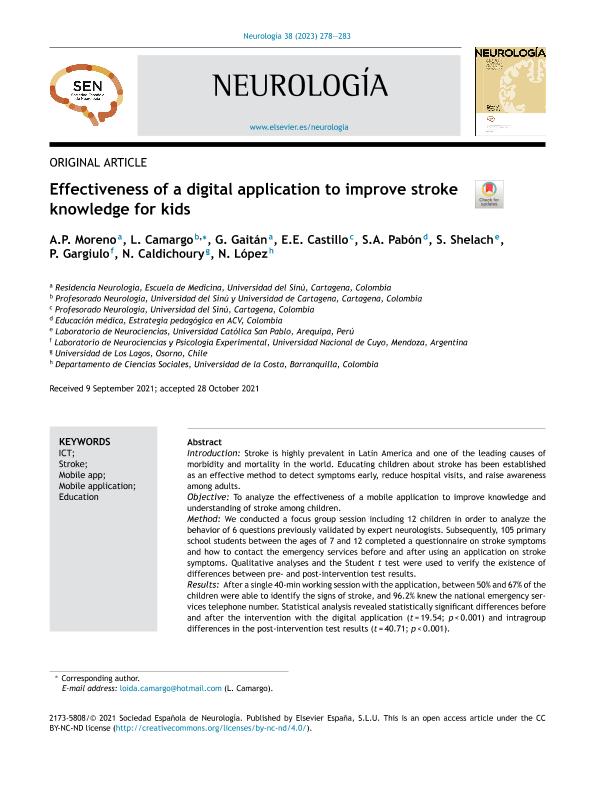Artículo
Introducción: El ictus es muy prevalente en Latinoamérica y constituye una de las principales causas de morbimortalidad a nivel mundial. Se ha sugerido que ensenar ˜ a los ninos ˜ a reconocer los primeros síntomas de ictus puede ayudar a reducir el número de ingresos por esta enfermedad y a concienciar a la población adulta. Objetivo: Analizar la efectividad de una aplicación móvil para aumentar el conocimiento del ictus en los ninos. ˜ Método: Llevamos a cabo una sesión con un grupo focal de 12 ninos ˜ para analizar el comportamiento de 6 preguntas previamente validadas por un grupo de neurólogos expertos. Posteriormente, administramos un cuestionario sobre síntomas de ictus y servicios de emergencias a 105 ninos ˜ de entre 7 y 12 anos ˜ en dos momentos diferentes: antes y después de usar la aplicación sobre síntomas de ictus. Se realizaron análisis cualitativos y se aplicó la prueba t de Student para confirmar la presencia de diferencias en las respuestas al cuestionario antes y después de la intervención. Resultados: Tras una única sesión de 40 minutos con la aplicación, entre el 50% y el 67% de los ninos ˜ eran capaces de identificar los síntomas de ictus y el 96,2% se sabían el número de teléfono de emergencias. El análisis estadístico reveló diferencias estadísticamente significativas entre los resultados del cuestionario antes y después de la intervención (t = 19,54; P < 0,001), así como diferencias intragrupo en los resultados postintervención (t = 40,71; P < 0,001). Conclusión: Los ninos ˜ que utilizaron nuestra aplicación acabaron sabiendo más sobre los síntomas de ictus y cómo actuar. Introduction: Stroke is highly prevalent in Latin America and one of the leading causes ofmorbidity and mortality in the world. Educating children about stroke has been establishedas an effective method to detect symptoms early, reduce hospital visits, and raise awarenessamong adults.Objective: To analyze the effectiveness of a mobile application to improve knowledge andunderstanding of stroke among children.Method: We conducted a focus group session including 12 children in order to analyze thebehavior of 6 questions previously validated by expert neurologists. Subsequently, 105 primaryschool students between the ages of 7 and 12 completed a questionnaire on stroke symptomsand how to contact the emergency services before and after using an application on strokesymptoms. Qualitative analyses and the Student t test were used to verify the existence ofdifferences between pre- and post-intervention test results.Results: After a single 40-min working session with the application, between 50% and 67% of thechildren were able to identify the signs of stroke, and 96.2% knew the national emergency servicestelephone number. Statistical analysis revealed statistically significant differences beforeand after the intervention with the digital application (t = 19.54; p < 0.001) and intragroup differences in the post-intervention test results (t = 40.71; p < 0.001).Conclusion: Primary school children who used our digital application increased their knowledge,understanding, and learning of stroke symptoms.
Effectiveness of a digital application to improve stroke knowledge for kids
Título:
Efectividad de una aplicación móvil para mejorar el conocimiento sobre los síntomas de ictus en una población pediátrica de Colombia
Moreno, A .P.; Camargo, L.; Gaitán, G.; Castillo, E. E.; Pabón, S. A.; Shelach, S.; Gargiulo, Pascual Angel ; Caldichoury, N.; López, N.
; Caldichoury, N.; López, N.
 ; Caldichoury, N.; López, N.
; Caldichoury, N.; López, N.
Fecha de publicación:
05/2023
Editorial:
Elsevier
Revista:
Neurología
ISSN:
2173-5808
Idioma:
Inglés
Tipo de recurso:
Artículo publicado
Clasificación temática:
Resumen
Palabras clave:
TIC
,
ICTUS
,
APP
,
APLICACIÓN
,
EDUCACIÓN
Archivos asociados
Licencia
Identificadores
Colecciones
Articulos(CCT - MENDOZA)
Articulos de CTRO.CIENTIFICO TECNOL.CONICET - MENDOZA
Articulos de CTRO.CIENTIFICO TECNOL.CONICET - MENDOZA
Citación
Moreno, A .P.; Camargo, L.; Gaitán, G.; Castillo, E. E.; Pabón, S. A.; et al.; Effectiveness of a digital application to improve stroke knowledge for kids; Elsevier; Neurología; 38; 4; 5-2023; 278-283
Compartir
Altmétricas



